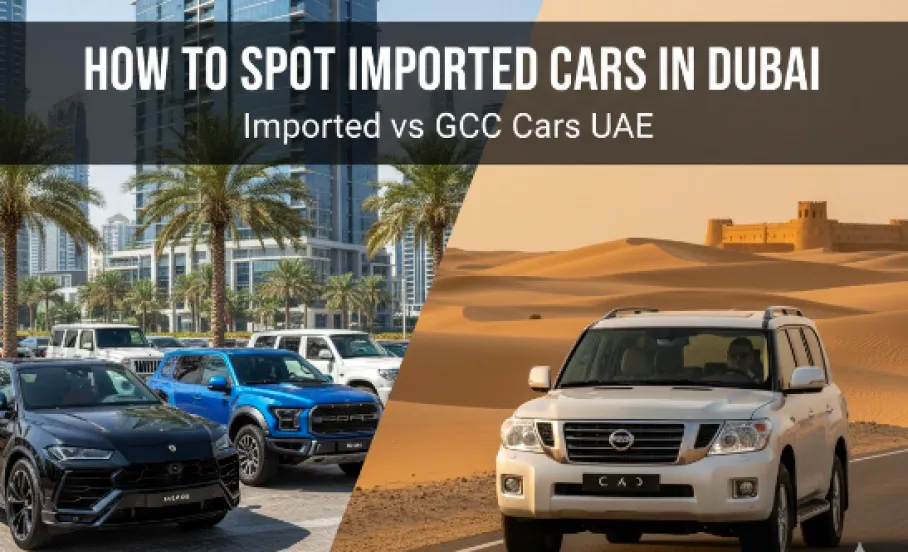How to Spot Imported Cars in Dubai and Avoid Overpriced Listings
Buying a used car in Dubai can be an exciting experience — but also a confusing one if you don’t know whether a vehicle is GCC-spec or an import. Many buyers get surprised later when they discover their car came from the U.S., Japan, or Canada and isn’t fully suited for Gulf conditions.
In this guide, we’ll show you how to check a car’s origin, what to look for visually and technically, and how to avoid paying GCC-level prices for imported cars.
What’s the Difference Between GCC and Imported Cars?
Before you start inspecting, it helps to know the basics:
- GCC-spec cars are built for hot weather, sandy conditions, and high humidity. They have stronger cooling systems, upgraded air filters, and corrosion-resistant components.
- Imported cars, especially from the U.S. or Japan, might not have these upgrades. They’re often cheaper — but repairs and parts can become costly in the UAE climate.
A quick rule of thumb:
GCC cars = better resale, better durability, and easier service.
How to Visually Identify Imported Cars in Dubai
Here’s what most people miss — subtle details that reveal where a car came from:
- Speedometer and odometer:
- GCC cars show km/h as the primary unit.
- U.S. imports show mph (miles per hour) — sometimes with km/h in smaller font.
- Infotainment system language and radio frequency:
-
- GCC cars tune to even-numbered FM frequencies (e.g., 100.2, 100.6).
- U.S. cars often tune only to odd frequencies (100.1, 100.3).
- Air conditioning vents and cooling strength:
-
- GCC cars usually have stronger dual-zone or rear AC systems optimized for desert heat.
- Labels and VIN stickers:
-
- Check the driver door frame or under the hood. The label often says Manufactured for the GCC or lists the country of import (e.g., USA, Japan, Canada).
- Headlights and taillights:
-
- North American cars have amber rear indicators, while GCC models usually use red or clear indicators with built-in fog lamps.
How to Technically Check a Car’s Origin in Dubai
Visual checks are a good start, but the best way to confirm is by checking the Vehicle Identification Number (VIN).
Here’s how to do it:
- Find the VIN on the dashboard, door frame, or registration card.
- Run a vehicle history check using official UAE systems.
→ Visit the UAE Ministry of Interior vehicle check page to verify origin, registration, and accident history.
- If it’s a U.S. import, you can cross-check it using websites like Carfax or AutoCheck.
Why Imported Cars Are Cheaper — and Sometimes Riskier
Imported cars are often 10–30% cheaper because they may have:
- Accident history abroad (salvage or rebuilt titles).
- Different mechanical specs, especially cooling and emissions systems.
- Limited warranty coverage in the UAE.
That said, not all imports are bad deals. Some are in excellent condition and well-maintained — just make sure the price reflects that status.
Tips to Avoid Overpaying for Imported Cars
Always ask the seller directly: “Is it GCC or import?”
Check the VIN and paperwork before committing.
Compare similar listings on trusted marketplaces to see fair GCC pricing.
If unsure, bring a professional inspection service — they can spot import-specific red flags instantly.
Final Thoughts
In Dubai’s fast-paced used car market, knowledge is power. Knowing how to spot imported cars helps you save money, avoid unexpected repairs, and negotiate smarter. Always verify the vehicle’s origin through the UAE MOI vehicle check before making a purchase.
If you’re shopping for GCC-spec used cars in Dubai, visit Auto Trader UAE — the trusted platform for verified listings and expert automotive guides. Find your next used car in Dubai today with confidence.
read more: GCC vs Non-GCC Spec Cars in Dubai | Key Differences Explained
Why GCC Specs Matter When Buying a Used Car in the UAE

